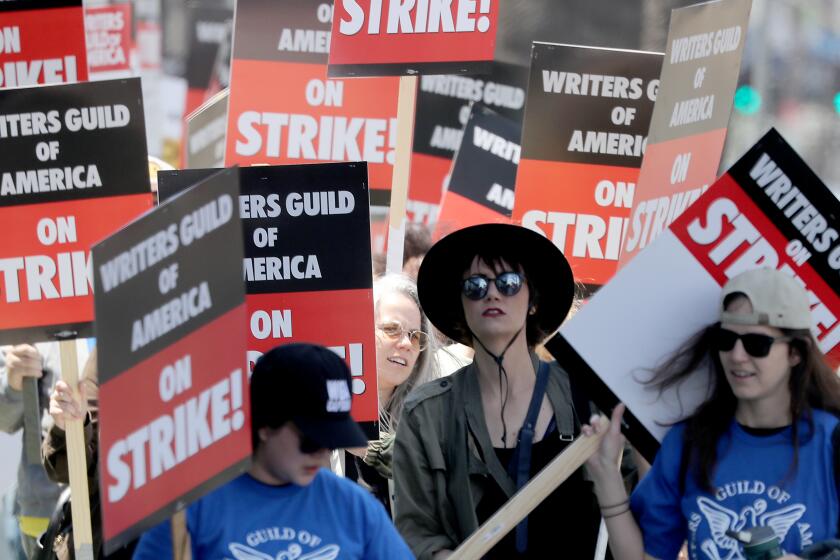Disney+ sheds 4 million subscribers. Iger plans ‘one app experience’ with Hulu shows

- Share via
Walt Disney Co.’s streaming video business narrowed its financial losses in the most recent fiscal quarter compared with a year earlier.
But the company’s flagship online service, Disney+, lost subscribers for the second straight quarter because of soft results from its direct-to-consumer product in India.
Disney+ lost a total of 4 million subscribers during the three months that ended April 1, the Burbank entertainment giant said Wednesday.
Inside the business of entertainment
The Wide Shot brings you news, analysis and insights on everything from streaming wars to production — and what it all means for the future.
You may occasionally receive promotional content from the Los Angeles Times.
The streaming decline primarily stemmed from the struggles of the low-cost Disney+ Hotstar service, which has suffered from the loss of streaming rights to Indian Premier League cricket matches.
This comes after Disney+ shed 2.4 million subscribers during the first quarter, marking the first such drop for the service since it launched in November 2019. Disney+ now has a total of 157.8 million subscribers globally.
Disney is in the midst of a major cost-cutting effort in the pursuit of higher profits as streaming continues to eat into earnings.
Chief Executive Bob Iger, who returned to the company in November, has been on a mission to find $5.5 billion in cost savings, including by cutting a projected 7,000 jobs across the company. So far, Disney has shed 4,000 of those roles through two rounds of layoffs and eliminations of unfilled positions.
“We’re pleased with our accomplishments this quarter, including the improved financial performance of our streaming business, which reflect the strategic changes we’ve been making throughout the company to realign Disney for sustained growth and success,” Iger said in a statement. “[W]e continue to deliver for consumers, while establishing a more efficient, coordinated, and streamlined approach to our operations.”
Crucially, Disney lost less money from its direct-to-consumer segment, which is composed of Disney+, Hulu and ESPN+.
Disney’s streaming businesses posted an operating loss of $659 million during the second quarter, compared with an $887-million loss in the same quarter last year. Disney has promised investors that the service will be profitable by the end of fiscal 2024.
Disney’s average revenue per user also improved after the company raised its subscription prices. Domestic revenue per subscriber increased 20% to $7.14 a month.
Speaking to analysts, Iger announced that the company will create a “one app experience” for domestic customers by adding Hulu content to Disney+. The company hopes this option will be attractive to advertisers and subscribers.
Hulu is the streaming home of Disney’s movies and TV shows that don’t fall neatly into Disney’s well-known brands, such as Pixar, Star Wars and Marvel. Such “general entertainment” content includes Hulu originals such as “Only Murders in the Building” and ABC’s “Abbott Elementary.”
The single app will be targeted at customers who subscribe to both Disney+ and Hulu, Iger said. Disney will continue to offer both apps as standalone options.
“It’s clear that a combination of the content that is on Disney+ with general entertainment is ... a very strong combination,” Iger said.
Additionally, the company expects to take a $1.5-billion to $1.8-billion write-down for removing certain content from its streaming platforms, echoing a strategy that Warner Bros. Discovery CEO David Zaslav has taken in reorienting HBO Max. Iger said Disney is looking to reduce the amount of content it produces for streaming.
Still, Disney is counting on streaming to keep the company relevant as its traditional TV business continues to decline.
Profits from Disney’s TV networks — including ABC, ESPN and Freeform — plummeted 35% year over year to $1.82 billion. Disney cited rising costs for sports content, combined with lower results derived from affiliate fees and advertising sales.
Overall, Disney reported quarterly revenue of $21.8 billion, up 13% from a year earlier and slightly exceeding the average estimates of analysts polled by FactSet. Profit more than doubled to $1.27 billion and matched analyst expectations.
Disney took a $150-million hit from severance costs related to the layoffs.
Profit from the parks, experiences and products business, which also includes international resorts, cruise lines and toy licensing, surged 23% to $2.17 billion.
Disney, like other legacy media companies, is reckoning with the harsh realities of the streaming business after years of rapid growth as it tried to compete with Netflix.
Disney+ started strong, quickly soaring during the COVID-19 pandemic as families were desperate for entertainment options.
But the streaming industry has lost steam during the last year or so, and Wall Street has demanded a realistic path to profitability for the money-losing apps — not just Disney+, but also rivals such as HBO Max, Peacock and Paramount+.
The earnings report came as Walt Disney Co. faces a challenge from an outsider, billionaire investor Nelson Peltz, who is seeking election to join the board.
Not counting India, Disney+ fared better, though its rise has stagnated noticeably, raising doubts about whether it can hit its subscriber targets.
Disney+ tallied 104.9 million subscribers worldwide, excluding Hotstar, gaining just 600,000 subscribers for an increase of 1% from the prior quarter. Subscriber counts fell by about 300,000, or 1%, in the U.S. and Canada but rose 2% internationally.
Hulu’s performance was flat, ending the quarter with 43.7 million subscribers, up just 200,000 from December.
Disney owns a controlling 66% of Hulu, while rival Comcast owns 33%. Disney can buy Comcast’s stake in early 2024, but Iger has been noncommittal about its plans.
“How that ultimately unfolds is to some extent in the hands of Comcast,” Iger said.
Meanwhile, Disney is in the midst of a legal battle with Florida Gov. Ron DeSantis over control of a special district that encompasses Walt Disney World.
Disney sued DeSantis and other Florida officials in federal court for allegedly retaliating against the company by trying to strip it of its self-governing abilities in what was once called the Reedy Creek Improvement District. DeSantis moved to eliminate Disney’s privileges after the company criticized the Sunshine State’s so-called Don’t Say Gay law, which DeSantis supported.
The 2023 writers’ strike is over after the Writers Guild of America and the Alliance of Motion Picture and Television Producers reached a deal.
The board of supervisors DeSantis named to oversee Disney’s district has since sued Disney. Iger on Wednesday pointed out that Disney paid $1.1 billion in state and local Florida taxes last year.
“Does the state want us to invest more, employ more people and pay more taxes, or not?” Iger asked rhetorically.
The Hollywood writers’ strike came up only obliquely, despite the fact that picket lines have disrupted multiple productions throughout the entertainment industry, including the Disney+ Marvel Studios series “Daredevil: Born Again.”
Chief Financial Officer Christine McCarthy said Disney’s content spending for fiscal 2023 is expected to remain roughly the same as last year, “excluding any potential impacts from the writers’ strike.”
Some entertainment executives have said they expect to save money in the short term because of the Writers Guild of America work stoppage.
More to Read
Inside the business of entertainment
The Wide Shot brings you news, analysis and insights on everything from streaming wars to production — and what it all means for the future.
You may occasionally receive promotional content from the Los Angeles Times.













